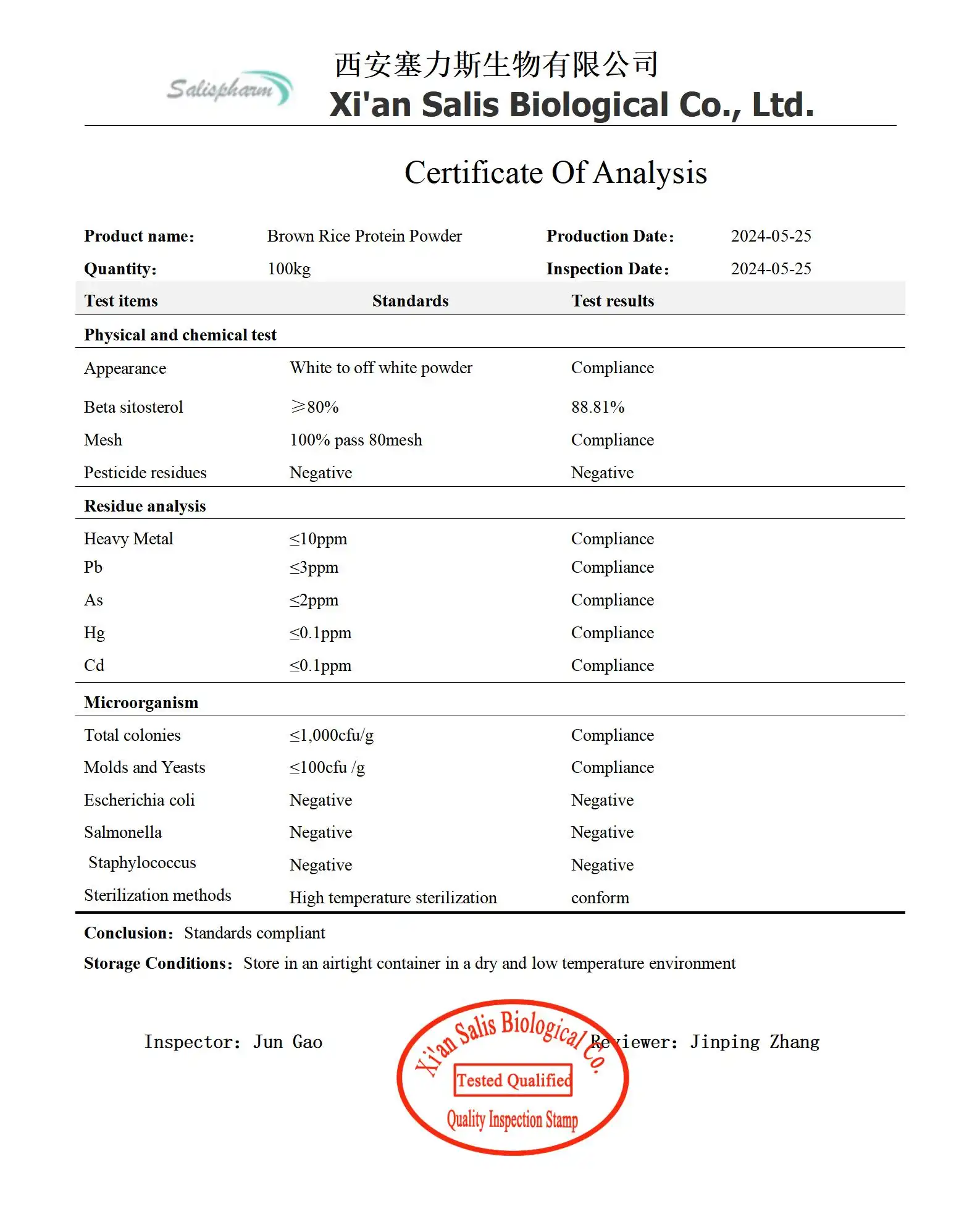Brown rice protein powder has gained significant popularity in recent years as a plant-based alternative to traditional protein supplements. This versatile and nutrient-rich powder is derived from whole grain brown rice and offers a wide range of benefits for various lifestyles and dietary needs. In this comprehensive guide, we'll explore the key aspects of brown rice protein powder, including its nutritional profile, potential health benefits, and practical applications in everyday life.

What are the benefits of brown rice protein powder?
Complete Amino Acid Profile
Brown rice protein powder is frequently praised for its emotional amino acid profile. While it's true that brown rice protein is n't a complete protein on its own, it comes veritably close to furnishing all the essential amino acids our bodies need. When combined with other factory- grounded protein sources or through the addition of specific amino acids during processing, brown rice protein greasepaint can offer a complete amino acid profile. This makes it an excellent choice for insectivores, insectivores, and anyone looking to diversify their protein sources. The amino acid composition of brown rice protein greasepaint includes high situations of cysteine and methionine, which are pivotal for colorful fleshly functions, including towel form and vulnerable system support.
Digestibility and Allergen-Friendly
One of the name benefits of brown rice protein greasepaint is its high insipidity. Unlike some other protein sources, similar as whey or soy, brown rice protein is generally well- permitted by utmost individualities. This is particularly salutary for those with sensitive digestive systems or those prone to gastrointestinal discomfort. also, brown rice protein greasepaint is naturally gluten-free and hypoallergenic, making it an excellent option for individualities with gluten perceptivity or disinclinations to common protein sources like dairy or soy. The gentle nature of brown rice protein on the digestive system means that it can be consumed regularly without causing bloating or discomfort, allowing for harmonious protein input to support muscle growth and recovery.
Rich in Antioxidants and Nutrients
Brown rice protein greasepaint is n't just a source of protein; it's also packed with colorful salutary composites. The greasepaint retains numerous of the nutrients set up in whole brown rice, including fiber, vitamins, and minerals. It's particularly rich in B-complex vitamins, which are essential for energy product and overall metabolic health. also, brown rice protein greasepaint contains antioxidants, similar as ferulic acid and oryzanol, which have been linked to colorful health benefits. These antioxidants help cover cells from oxidative stress and may contribute to bettered heart health, reduced inflammation, and enhanced overall well- being. The presence of these fresh nutrients makes brown rice protein greasepaint a more holistic supplement option compared to insulated protein sources.
How does brown rice protein powder compare to other protein sources?
Nutritional Comparison
When comparing Brown rice protein powder to other protein sources, it's important to consider colorful nutritive aspects. In terms of protein content, brown rice protein greasepaint generally contains about 24- 26 grams of protein per 30- gram serving, which is similar to whey protein. still, it's worth noting that the amino acid profile of brown rice protein is slightly different. While it's rich in certain amino acids like cysteine and methionine, it's fairly lower in lysine compared to beast- grounded proteins. This is why it's frequently recommended to combine brown rice protein with other factory- grounded proteins to produce a more complete amino acid profile. In terms of carbohydrates and fats, brown rice protein greasepaint is generally low in both, making it a spare protein source. It also contains further fiber than numerous beast- grounded protein maquillages, which can be salutary for digestive health and malnutrition.[i 4
Digestibility and Absorption
The insipidity of brown rice protein greasepaint is a crucial factor in its comparison to other protein sources. While it may not be as fleetly absorbed as whey protein, studies have shown that brown rice protein is still well- digested and employed by the body. The Protein Insipidity Corrected Amino Acid Score( PDCAAS) for brown rice protein is around 0.7, which is lower than that of whey or soy but advanced than numerous other factory- grounded proteins. still, the slower digestion rate of brown rice protein can be profitable for sustained protein release, potentially abetting in muscle recovery and growth over a longer period. also, the hypoallergenic nature of brown rice protein greasepaint makes it a more protean option for those with salutary restrictions or perceptivity to common allergens set up in other protein sources.
Environmental and Ethical Considerations
When assessing protein sources, it's decreasingly important to consider their environmental impact and ethical counteraccusations . Brown rice protein greasepaint stands out in this regard as a sustainable and environmentally friendly option. The product of factory- grounded proteins generally requires smaller coffers and produces lower hothouse gas emigrations compared to beast- grounded proteins. Brown rice civilization is also generally less water- ferocious than some other crops used for protein greasepaint product. From an ethical viewpoint, brown rice protein greasepaint is suitable for insectivores and insectivores, aligning with factory- grounded cultures and beast weal enterprises. These factors make brown rice protein greasepaint an seductive choice for environmentally conscious consumers and those seeking to reduce their carbon footmark through their salutary choices.
Can brown rice protein powder help with weight loss and muscle gain?
Role in Weight Management
Brown rice protein powder can play a significant role in weight management strategies. Its high protein content helps promote satiety, potentially reducing overall calorie intake by keeping you feeling full for longer periods. This can be particularly beneficial for those looking to lose weight or maintain a healthy weight. The low fat and carbohydrate content of brown rice protein powder also makes it a suitable option for calorie-controlled diets. Additionally, the fiber content in brown rice protein powder can contribute to improved digestion and regular bowel movements, which are important aspects of overall weight management. Some studies have suggested that incorporating plant-based proteins like brown rice protein into a weight loss diet may lead to greater reductions in body weight and fat mass compared to animal-based proteins, although more research is needed to confirm these findings.
Muscle Building and Recovery
Despite the common misconception that plant-based proteins are inferior for muscle building, brown rice protein powder has shown promising results in this area. A study published in the Nutrition Journal found that brown rice protein was as effective as whey protein in supporting muscle growth and recovery when consumed post-exercise. This is particularly encouraging for athletes and fitness enthusiasts looking for plant-based alternatives. The amino acid profile of brown rice protein, particularly its high content of branched-chain amino acids (BCAAs), supports muscle protein synthesis and recovery. While it may be slightly lower in leucine compared to whey protein, the overall BCAA content is still substantial enough to support muscle growth. For optimal results, combining brown rice protein powder with a balanced diet and regular resistance training can effectively support muscle gain and strength improvements.
Metabolic Health and Energy
Beyond its direct impact on weight and muscle, brown rice protein powder can contribute to overall metabolic health and energy levels. The B-vitamins present in brown rice protein powder play crucial roles in energy metabolism, helping to convert food into usable energy for the body. This can be particularly beneficial for individuals engaged in regular physical activity or those looking to boost their overall energy levels. Furthermore, the steady release of amino acids from brown rice protein can help maintain stable blood sugar levels, which is important for sustained energy throughout the day and can be beneficial for managing conditions like diabetes. The antioxidants present in brown rice protein powder may also contribute to improved metabolic health by reducing oxidative stress and inflammation, which are often associated with various metabolic disorders.
Conclusion
Brown rice protein powder offers a versatile, nutritious, and environmentally friendly option for those seeking to enhance their protein intake. Its benefits range from supporting muscle growth and weight management to providing essential nutrients and antioxidants. While it may have slight differences compared to animal-based proteins, its overall profile makes it a valuable addition to various diets and lifestyles. As with any dietary supplement, it's important to consider individual needs and consult with a healthcare professional when incorporating brown rice protein powder into your routine.
If you are also interested in this product and want to know more product details, or want to know about other related products, please feel free to contact lea_slsbio@163.com,WhatsApp+86 13193326505.

References
- Joy, J. M., et al. (2013). The effects of 8 weeks of whey or rice protein supplementation on body composition and exercise performance. Nutrition Journal, 12(1), 86.
- Kalman, D. S. (2014). Amino Acid Composition of an Organic Brown Rice Protein Concentrate and Isolate Compared to Soy and Whey Concentrates and Isolates. Foods, 3(3), 394-402.
- Mohanty, B., et al. (2012). Rice and human nutrition. Indian Journal of Medical Research, 136(5), 675-678.
- Patel, S. (2015). Cereal bran fortified-functional foods for obesity and diabetes management: Triumphs, hurdles and possibilities. Journal of Functional Foods, 14, 255-269.
- Schaafsma, G. (2000). The Protein Digestibility–Corrected Amino Acid Score. The Journal of Nutrition, 130(7), 1865S-1867S.
- Van Vliet, S., et al. (2015). The Skeletal Muscle Anabolic Response to Plant- versus Animal-Based Protein Consumption. The Journal of Nutrition, 145(9), 1981-1991.

